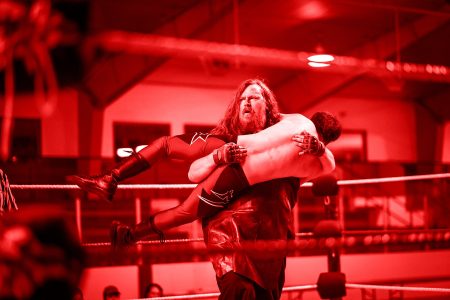
Professional wrestling is art, but a more complicated art form than most academics or arts professionals can fully understand as no amount of book-based research can allow one to comprehend this art form in its entirety.
I could profile the history of professional wrestling which is well documented, or I could make citations to validate my opinions, but I shall leave such endeavours to wrestling scholars as they are far more willing to spend time chronicling this vast subject than I am.
The only way to really learn about wrestling is to immerse yourself in a wrestling community; you must train, listen, and learn to become a wrestler. This is the only way to gain lived experiences necessary to fully understand professional wrestling as a way of life and an art form.
My career in the arts has led me to some of the highest profile organizations and experiences that Canada has to offer over the last two decades. I’ve been on the board of trustees for the National Gallery of Canada. I have won the Chalmers Arts Fellowship twice. I have sat on countless adjudication committees to give out grants and awards across the country. I’ve also worked with the National Film Board of Canada and the Toronto International Film Festival to create new works. All this is in addition to being a multi-disciplinary artist and arts worker working in many capacities in festivals, galleries, and artist-run centres, and currently holding the position of Executive Director for the Artist-run Centres and Collective Conference (ARCA), an arts service organization which serves approximately 200 arts groups.
Basically, I know a lot about art stuff. Which is why I say with confidence that professional wrestling is not performance art.
Performance art within a contemporary art context is a performative arts action that is performed by artists. The performance can be as nuanced or complicated as professional wrestling but often is not. Contemporary artists have rich and complicated backgrounds like wrestlers, but they do not receive the same unifying training or experiences that form the many ideals that wrestlers hold in their careers. In the arts there are fewer shared values and no expectations or standardization of relationships. Artists are a random bunch each uniquely pursuing their practices without following each other rigidly. Artists each do their own thing even when collaborating with other artists.
In wrestling the opposite is true. Direct training and mentorships are the foundation of professional wrestling and the primary reason we shouldn’t define wrestling within any other art form or attempt to put parameters around professional wrestling at all.
Performance artists often work alone building a context of how they wish to communicate their artistic statement with their work. Professional wrestling training requires wrestlers to work collaboratively towards shared goals to ensure that they can achieve their goals without injuring each other. Artists do not have to work with each other; they can perform alone but wrestlers require an opponent to make their match work. They must negotiate the outcome based on their shared abilities, experiences, and the needs of the presenting company, and must do this while engaging the audience effectively.
Professional wrestling is the most complicated multi-arts practice that anyone can learn. It is a variety of art forms combined with a variety of athletics and sports. Imagine how complicated the acts within a circus show are for each of the dancers, freak show artists, gymnasts, clowns, lion tamers, fire breathers, strong men, acrobats, jugglers, and such. Now picture every single person having to have all those skills and be capable of implementing them simultaneously in an improvised match with another person with similar training.It sounds like a lot to know and manage but it does not even come close as an analogy.
It may be easier to attempt to put “performance art” into a category of professional wrestling than it would be to put professional wrestling into a category of performance art. This is also why I could be categorized as a multi-disciplinary artist and performance artist who lives as a professional wrestler. www.rustyblackwell.com
Wrestling is the highest form of art in the way that many celebrated art forms are also considered sports. Figure skating tells stories through movement on ice at the Olympics and although figure skating is an intensely athletic and demanding profession, professional wrestling is vastly more complicated. So complicated that it would be almost impossible to objectively judge it as an Olympic sport as the adjudicators would have to be wrestlers to understand how to judge it effectively. Maybe we already have the equivalent of wrestling Olympics with groups like WWE, NJPW and OVW.
At its core, professional wrestling tells stories of conflict that allow audiences to invest and be part of the story. Because the stakes are high, there is a far deeper connection between wrestlers and their audience than in other art forms.
Theatre teaches us to be quiet and watch and to clap when appropriate. Film teaches us to be quiet and watch and to clap when appropriate. In some community arts events, engagement takes place and audiences participate. They become part of the show. Professional wrestling is like that all the time. It asks the audience to participate by cheering and shouting, and at times audiences are so invested that they are brought to tears or exhaustion from yelling so loudly.
This unique relationship with the audience does not exist outside of professional wrestling because the investment that the audience has in the conflict they witness is real. The outcomes of the story are predetermined as in many other art forms, but the severity and danger wrestlers face are very real. Lives are at stake as wrestlers can get badly injured or even die in the ring. The stories that are told are also serious, so much so that audiences have brought themselves to believe wrestling is real… because it is.
Instead of professional wrestling being considered “performance art,” or even as part of any art genre, I turn to the arts community of the world and ask, “How is your art already part of professional wrestling?” You’d be surprised to find out just how much of what you do is already part of the wrestling industry.
Professional wrestling is not performance art. Attempting to recontextualize such a complicated and deeply rooted community into any category other than their own is just an insult.
Professional wrestling is always going to be professional wrestling. Until wrestlers say otherwise.
